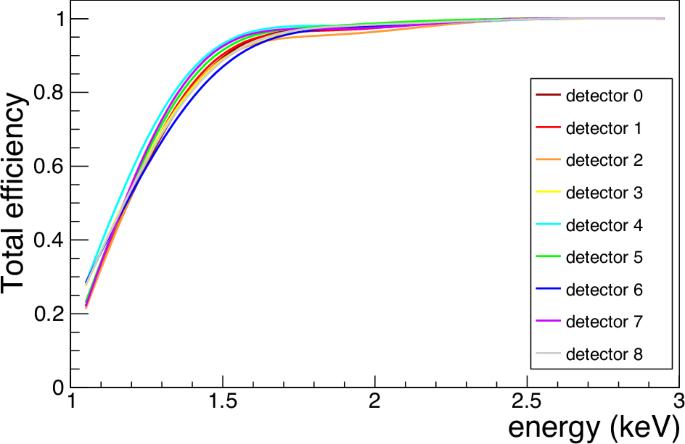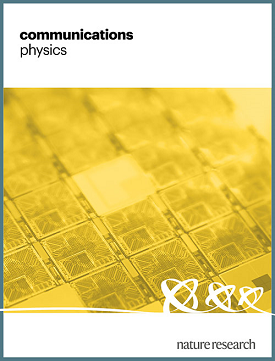ANAIS–112 three years data: a sensitive model independent negative test of the DAMA/LIBRA dark matter signal
IF 5.4
1区 物理与天体物理
Q1 PHYSICS, MULTIDISCIPLINARY
引用次数: 0
Abstract
Weakly interacting massive particles (WIMPs) are well-motivated candidates for dark matter. One signature of galactic WIMPs is the annual modulation expected in a detector’s interaction rate, which arises from Earth’s revolution around the Sun. Over two decades, the DAMA/LIBRA experiment has observed such modulation with 250 kg of NaI(Tl) scintillators, in accordance with WIMP expectations but inconsistent with the negative results of other experiments. The signal depends on the target material, so to validate or refute the DAMA result, the experiment must be replicated using the same material. This is the goal of the ANAIS–112 experiment, currently underway since August 2017 with 112.5 kg of NaI(Tl). In this work, we present a reanalysis of three years of data employing an improved analysis chain to enhance the experimental sensitivity. The results presented here are consistent with the absence of modulation and inconsistent with DAMA’s observation at nearly 3σ confidence level, with the potential to reach a 5σ level within 8 years from the beginning of the data collection. Additionally, we explore the impact of different scintillation quenching factors in the comparison between ANAIS–112 and DAMA/LIBRA. The DAMA/LIBRA experiment has observed a clear signal of dark matter for over 20 years. Although this signal contradicts the negative results of other experiments, it cannot be dismissed without replication using the same material. The authors present the negative results from the ANAIS-112 experiment, which uses the same target and shows strong tension with DAMA/LIBRA

ANAIS-112三年数据:对DAMA/LIBRA暗物质信号进行与模型无关的灵敏负测试
弱相互作用大质量粒子(WIMPs)是暗物质的动机良好的候选者。银河系 WIMPs 的一个特征是探测器的相互作用率每年都会发生调制,这种调制是由地球绕太阳公转引起的。二十年来,DAMA/LIBRA 实验用 250 千克 NaI(Tl)闪烁体观测到了这种调制,符合 WIMP 的预期,但与其他实验的负面结果不一致。信号取决于目标材料,因此要验证或反驳 DAMA 的结果,必须使用相同的材料复制实验。这就是 ANAIS-112 实验的目标,该实验自 2017 年 8 月开始进行,目前使用了 112.5 千克 NaI(Tl)。在这项工作中,我们采用改进的分析链对三年的数据进行了重新分析,以提高实验灵敏度。本文介绍的结果与不存在调制的情况一致,与 DAMA 的观测结果不一致,置信度接近 3σ,有可能在数据收集开始后的 8 年内达到 5σ 的水平。此外,我们还在 ANAIS-112 和 DAMA/LIBRA 的比较中探讨了不同闪烁淬灭因子的影响。20 多年来,DAMA/LIBRA 实验观测到了暗物质的明显信号。虽然这一信号与其他实验的负面结果相矛盾,但如果不使用相同的材料进行复制,就不能否定这一信号。作者介绍了 ANAIS-112 实验的负面结果,该实验使用了相同的目标,并显示出与 DAMA/LIBRA 实验强烈的紧张关系。
本文章由计算机程序翻译,如有差异,请以英文原文为准。
求助全文
约1分钟内获得全文
求助全文
来源期刊

Communications Physics
Physics and Astronomy-General Physics and Astronomy
CiteScore
8.40
自引率
3.60%
发文量
276
审稿时长
13 weeks
期刊介绍:
Communications Physics is an open access journal from Nature Research publishing high-quality research, reviews and commentary in all areas of the physical sciences. Research papers published by the journal represent significant advances bringing new insight to a specialized area of research in physics. We also aim to provide a community forum for issues of importance to all physicists, regardless of sub-discipline.
The scope of the journal covers all areas of experimental, applied, fundamental, and interdisciplinary physical sciences. Primary research published in Communications Physics includes novel experimental results, new techniques or computational methods that may influence the work of others in the sub-discipline. We also consider submissions from adjacent research fields where the central advance of the study is of interest to physicists, for example material sciences, physical chemistry and technologies.
 求助内容:
求助内容: 应助结果提醒方式:
应助结果提醒方式:


